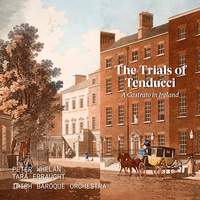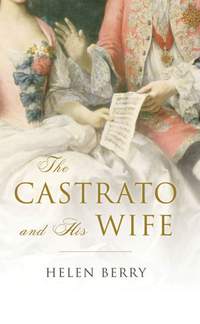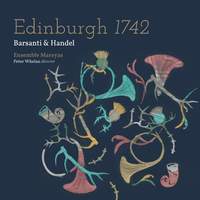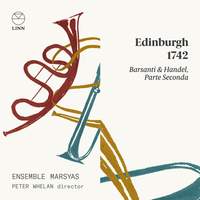Interview,
Peter Whelan on The Trials of Tenducci
 Conductor and bassoonist Peter Whelan's exuberant explorations of musical life in 1740s Edinburgh with Ensemble Marsyas are firm favourites with the Presto editorial team, and for his latest recording project he's crossed the Irish Sea (both literally and metaphorically) to investigate the concert-scene in Dublin a decade or two later. The focal point of the album is the remarkable career of the Sienese castrato Giusto Fernando Tenducci, whose biography could surely supply the raw material for a salacious costume-drama to rival Bridgerton - and whose flamboyant shoes are filled with breathtaking aplomb here by the Irish mezzo Tara Erraught.
Conductor and bassoonist Peter Whelan's exuberant explorations of musical life in 1740s Edinburgh with Ensemble Marsyas are firm favourites with the Presto editorial team, and for his latest recording project he's crossed the Irish Sea (both literally and metaphorically) to investigate the concert-scene in Dublin a decade or two later. The focal point of the album is the remarkable career of the Sienese castrato Giusto Fernando Tenducci, whose biography could surely supply the raw material for a salacious costume-drama to rival Bridgerton - and whose flamboyant shoes are filled with breathtaking aplomb here by the Irish mezzo Tara Erraught.
I spoke to Peter about Tenducci's manifold trials and tribulations, the music which he inspired and popularised, and some of the other international musicians and composers who contributed to Dublin's rich and varied cultural life in the mid-eighteenth century...
How did musical life in eighteenth-century Dublin compare to the cultural scene in London or Edinburgh at the time?
London of course was the No. 1 centre, but Dublin was clearly No. 2: it was the second-biggest economy in the British Isles, so it was really worthwhile to travel over there. Edinburgh was much smaller, and whilst it could rival Dublin on purely cultural terms it came further down the list overall because there wasn’t as much money knocking around. Dublin was definitely Party Central at that particular moment: Handel paved the way when he came over in the 1740s, and the Irish generally loved to let their hair down more than the Scots! This era is often described as Ireland’s ‘Golden Age’, because it was the longest extended period of peace for centuries: they had a run of a hundred years that was essentially free from conflict, and absolutely made the most of it.
Dublin had a special energy at this point in history, and its theatre world really took off in the 1750s and 60s – actors like David Garrick (and every singer worth their salt) would have travelled across the Irish Sea, which was quite the ordeal back then! I recently saw a commonplace book by a musician who made the journey to Ireland in 1707, and in some respects things ran like clockwork as there was plenty of information available about crossing-times and connections. But you could still get stuck in the sand: Handel got stranded at Parkgate, near Chester, for several days! Nonetheless it was definitely worth it, because performers all worked out that you could make top dollar in Dublin if you risked the journey across the seas - and Tenducci was one of the most famous to do so.
Were Italian musicians as predominant in Dublin as they were in London around this time?
You see a lot of Italian names cropping up in all three musical centres in the British Isles: Barsanti was one of the first to establish himself in Edinburgh, and to this day there are big families with Italian names who’ve been there ever since. And Ireland is similar, because all things Italian were very much in vogue in the top tier of society: everybody was building Palladian mansions, and people were bringing bits of Italy home with them from their Grand Tours. There are so many beautiful stately homes in Ireland that people aren’t so aware of, covered in stucco – it can feel like you’re in Florence or Venice!
What set you on Tenducci’s trail?
Helen Berry’s book The Castrato and His Wife was the main impetus for the project, because the story she tells is so brilliant, and it set me on a mission to find out what he would have been singing in Ireland whilst all of that was going on. With the Irish Baroque Orchestra the plan is always to tell stories: I think a really effective way of bringing relatively little-known music to life is to have a character like this who’s so fascinating on their own terms, and then to create a little musical portrait of what people would have heard them perform at the time.
 In a way we’re mirroring Tenducci’s journey by using Tara Erraught, who’s one of the greatest singers in Ireland at the moment: like him she’s an international superstar at the top of her game, and I thought it was important to bring in that element as part of the narrative. I’m so grateful and delighted that someone of her calibre agreed to this project, and there are lots of reasons why I think the match between Tara and Tenducci is a good one. All the coloratura is there, and the beautiful sound, but she’s got something extra as well – a kind of soulfulness that was also part of Tenducci’s appeal, because he was famous for selling Irish and Scottish melodies as well as being an opera star. He could generate magic through the simplest of tunes, and Tara can do that too, taking singing back to its purest form.
In a way we’re mirroring Tenducci’s journey by using Tara Erraught, who’s one of the greatest singers in Ireland at the moment: like him she’s an international superstar at the top of her game, and I thought it was important to bring in that element as part of the narrative. I’m so grateful and delighted that someone of her calibre agreed to this project, and there are lots of reasons why I think the match between Tara and Tenducci is a good one. All the coloratura is there, and the beautiful sound, but she’s got something extra as well – a kind of soulfulness that was also part of Tenducci’s appeal, because he was famous for selling Irish and Scottish melodies as well as being an opera star. He could generate magic through the simplest of tunes, and Tara can do that too, taking singing back to its purest form.
Was Tenducci attracted to Dublin purely for economic reasons, or were there other factors involved?
It’s all a little bit shady. I think he’d already done Artaxerxes for JC Bach in London when he ran into awful problems: he was in a debtors’ prison for a while, and he’d also caused a scandal with a nobleman’s wife, so there was reason enough for him to get out of town! He definitely had some incentive to come to Dublin thanks to the composer Tommaso Giordani, whose music features on the recording: he most likely composed ‘Caro mio ben’ and also taught John Field, the only famous Irish composer of the Classical period. Giordani’s family had a few contracts in different theatres in Dublin, and we see these two names associated with each other from the beginning. So it was really the Italian mafia who attracted Tenducci over!
And did his ‘trials’ continue after his arrival in Ireland?
When he arrived he was introduced to all the right people, and seemed to sail right to the top of society: he was from the lowest of the low in Italy, but he would have been very used to dealing with the upper crust, meeting royalty etc., and knew how to deport himself. The ‘trials’ that we’re referring to here began when he was teaching Dorothea Maunsell, the daughter of a lawyer from Irish Protestant stock who were very well-to-do and had a newly-built Georgian house in the most exclusive district of Dublin; rather like in The Rake’s Progress, Tenducci was brought in to be her singing-teacher, because the family assumed she’d be in safe hands with a ‘eunuch’.
But of course they fell wildly in love, eloped, and got married in a backstreet in Cork, with the family in hot pursuit; Tenducci even got thrown into Cork jail, and was released for a night to sing a benefit concert before getting locked up again! I think it was the Quakers who eventually got money together to release him, and the two got married again in a more legitimate way; they came back to the UK and eventually arrived in Edinburgh, where it was noted with astonishment that Dorothea was pregnant…Later on Casanova ran into them in London and noted that they had two children: his theory was that Tenducci had three testicles, one of which was somehow hidden away!
 And the story doesn’t end there. During the eventual divorce proceedings, the Maunsell family did a lot of research to support their argument that the marriage couldn’t have been consummated, and could therefore be annulled. They went back to the town in Siena where Tenducci had had ‘the chop’, and managed to track down the pig-castrator who’d done the job; because they were so wealthy, they were able to get various people to testify, so a lot of the gory details we have about castratos actually stem from this specific case. One of the witnesses who came forward was a grocer who’d lived with Tenducci in Dublin, and said he carried around the remnants of his testicles in a little silk bag for good luck, which I guess supports Casanova’s theory that there were three rather than two…
And the story doesn’t end there. During the eventual divorce proceedings, the Maunsell family did a lot of research to support their argument that the marriage couldn’t have been consummated, and could therefore be annulled. They went back to the town in Siena where Tenducci had had ‘the chop’, and managed to track down the pig-castrator who’d done the job; because they were so wealthy, they were able to get various people to testify, so a lot of the gory details we have about castratos actually stem from this specific case. One of the witnesses who came forward was a grocer who’d lived with Tenducci in Dublin, and said he carried around the remnants of his testicles in a little silk bag for good luck, which I guess supports Casanova’s theory that there were three rather than two…
All of these stories kept travelling through history, and even while Tenducci was still alive they were already mutating into folklore; the Arne aria ‘Water Parted from the Sea’ was a huge hit in Dublin, so much so that the little street-urchins would sing it like a nursery-rhyme, with the words changed around to reference Tenducci. That children’s song (including the mention of Tenducci) is referenced by James Joyce in Finnegan’s Wake, and more recently Gerald Barry wrote an opera about him called The Intelligence Park, so the story has really endured throughout art and literature.
Could you tell me a little about the purely instrumental works on the programme?
I’m from just outside Dublin, and I’ve always been fascinated by what was going on in the capital during this period: in school you’re taught that Handel came along and performed the first Messiah, but in terms of music, it seemed there was nothing before or after that, so it’s been a real joy to discover all of these pieces. One of the musicians who came over to Dublin was the Flemish composer-violinist Pierre van Maldere, who worked in the same hall as Handel for three years, and one of his symphonies opens the disc. I’m so pleased with these pieces – they’re so connected to Dublin, and so ahead of their time. The details are a bit hazy, but we do know that Mozart was inspired by him, and it’s easy to see why: this little piece is so fresh and just pops into life. I also get the feeling that van Maldere has just discovered dynamics: they were largely limited to piano and forte before, and now we have pianissimo and fortissimo, so it’s like he has this new technology to play with and can’t resist doing little ‘Mannheim rockets’ at every opportunity!
It was important to represent Giordani, given that he was the one who invited Tenducci to Ireland in the first place, and that’s a really fun piece because it has the cheesiest collection of Irish tunes! It’s a little like the medleys that Irish orchestras will sometimes play nowadays as part of a pops concert, but this is by far the earliest example. Giordano names all of the tunes on the manuscript, some of which are very famous to Irish children today: they’re the sort of things you learn to dance to in school, so it’s amazing to see them back-to-back like that. I re-orchestrated some of them from a piano part, and I’m hoping that Irish audiences (and especially the ex-pat Irish audiences in America) will be pleasantly surprised to hear them in a classical symphonic context. IBO’s violinist, Marja Gaynor can play both Trad and baroque violin and she led the way when it came to finding a style.
I also wanted to include a piece with oboe, because they were a big part of the Dublin concert-scene: like singers, instrumentalists from Europe realised there was good money to be made in Dublin, and bassoonists and oboists in particular could command hefty fees. Perhaps the most famous of these was Johann Christian Fischer, who was Mozart’s oboist for a lot of his career and was also very good friends with JC Bach; in fact Fischer, JC Bach and Tenducci travelled together a lot and were a famous triple-act in London. Fischer visited Dublin on a number of occasions and played his own concerto on Gramachree, which is an Irish phrase for ‘Love of my heart’, and of course that went down a storm with the Irish audiences. It was also an opportunity to showcase IBO’s wonderful oboist, Andreas Helm.
Speaking of Mozart, the booklet-notes mention that he composed a piece for Tenducci – do no sketches of this survive?
No, and it’s so frustrating! Tenducci gave Mozart singing-lessons when he was about ten, and Mozart was totally besotted with him. We know he definitely did write something for Tenducci, because he’s very specific about it in a letter – he says Tenducci arrived in Paris, he was delighted to see him, and very quickly put together an aria for him that was scored for orchestra plus solo fortepiano and four solo woodwinds. The few leads that there are on this all seem to peter out, but I live in hope…
Just to reference the Mozart connection we do include Exsultate, jubilate which was written for Tenducci’s contemporary and fellow castrato Venanzio Rauzzini. There’s still a link with Dublin there, because Rauzzini lived in the city for a long time and taught singing to a lot of Irish musicians, including Michael Kelly who was the first Basilio and Don Curzio in Mozart’s Le Nozze di Figaro. Rauzzini actually lived in the same square that’s on the cover of the disc, so despite the missing part of the puzzle it all joins up!
Tara Erraught (mezzo), Irish Baroque Orchestra, Peter Whelan
Available Formats: CD, MP3, FLAC, Hi-Res FLAC
Ensemble Marsyas, Peter Whelan
Available Formats: MP3, FLAC, Hi-Res FLAC
Ensemble Marsyas
Available Format: CD






